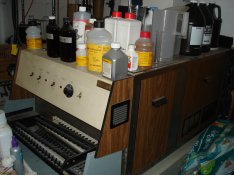RCP-20 tanks are normally filled with something like 2 liters of working solutions. The tanks are not all the way filled up. If overfilled contamination of one fluid from another will occur. The tanks do not have any overflow passage for the fluid to overflow. There are only 3 holes at the bottom of the tanks attached with 3 rubber hoses for draining. Everything is so simple. So yes, you could design and fabricate an overflow mechanism and a refilling device with precision measurement for accurate draining and refilling. Keep in mind that the amount of fluid to refill does not equal to the amount to overflow or to drain. There is constant loss of fluid by carrying over and vaporization. So it will not be trivial to figure out an accurate replenishing scheme. You will always need to fill more than the amount to drain.
By the way the workflow of a home darkroom optical color printing will be extremely slow. There is always one to two test prints done to figure out the correct filtration and exposure. If you are lucky you may hit it right on the money on your first print development. Don't expect to be able to crank out many prints on an evening or even on a day. The RCP-20 will likely to be rolling and rolling most of the time without actually processing anything. It doesn't take long for the house to be full of the chemical smell and yet not actually processing anything.
You write a lot about the shortcomings of the RCP-20, so I assume it is the only tabletop RT processor you know from first hand experience ... The thing is, the RPC-20 is not a particularly good RT processor, and then, it is not even a RA4 processor to begin with. I am therefore not sure how relevant your observations are for RA4 procesors in general.
I am using a Thermaphot RT processor in a "home processing situation", it does not possess automatic replenishment (although it was available as an option), but it has overflow ports and a clever design that restricts carryover of solutions to a minimum. For my needs it is sufficient to replenish the solutions manually once a day. Under certain circumstances, when printing a lot of bigger sheets (12x16), I might do it more often, like twice a day, but this is not the norm. Anyway, the idea that one has to replenish the tanks after every smallish print or every test 2x10 teststrip to ensure the repeatability of results is far from reality. The gerat thing about a RT machine is that you can do a lot of test strips in a row, testing out small variations in filter and exposure very conveniently and that actually helps you to become a much better printer in shorter time. My experience with a drum setup OTOH is that the necessary steps (cleaning, getting drum dry/prewet etc.) are so time consuming and cumbersome, especially for a beginner who still lacks the routine, that after the 3rd or 4th test strip you will say "screw it, this is good enough, I go for the big print now". This is actually a bad habit and not very helpful in getting good results or becoming a good printer, because you start to compromise on quality and will be disappointed sooner than later by your own efforts. In contrast, with a good RT processor, it is very convenient to do test after test strip until you really have found the ideal filter pack and exposure. It makes dialing in filtration and exposure a joy and you will learn very quickly.
Regarding the fumes, if you find that your house is full of fumes before you have even done your first print, your ventilation is absent or seriously lacking. RA4 processing should only be done with proper ventilation, irrespective of whether you use trays, drums or RT processors.
I am not saying a RT transport is the ideal machine for everyone and every application, but I find that especially for a beginner they are very helpful tools indeed, as they take away the burden of constnatly worrying about the formal aspects of the processing (rinsing drums, keeping temperature, prewet, observe processing times etc.) and let you concentrate on what is really enjoyable (at least for me), and that is the printing. So, for me a RT processor is very useful and makes sense in a home dakroom situation
if your usual printing habit is to use the darkroom for a whole day, or, even better, a couple of consecutive days. With the Thermaphot, you do not have to clean or empty the tanks or racks overnight, all you do is rinse the parts of the racks that are exposed to air with a bit of water and cover everything with the lid. In this way, you can print for a couple of days in a row or even a whole week with minimum maintenance. When you are finished with your printing sessions, you empty the tanks and clean the racks. This can be done in 30 minutes maximum.
If your darkroom habit is more like doing spontaneous sessions every now and then for a couple of hours and then leaving everything sit again for a couple of days or weeks, there are probably more efficient or practical solutions for processing RA4.














